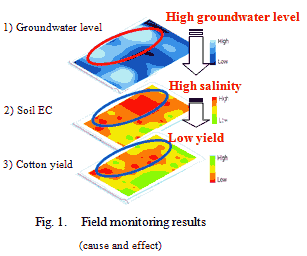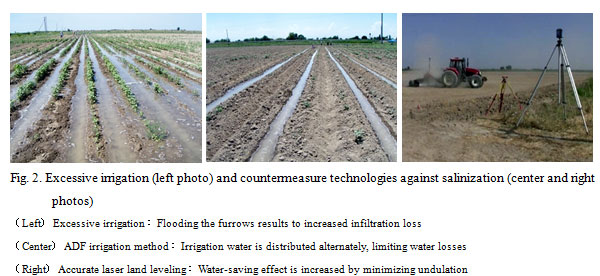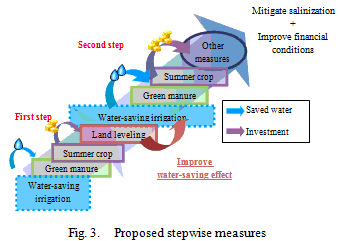Guideline on "On-farm mitigation measures against salinization under high groundwater level conditions"
Description
Excessive irrigation raises the groundwater table and causes water-logging. In arid or semi-arid zones, salts carried by river water or groundwater accumulate, resulting to decreased crop yields and abandonment in the case of highly salinized agricultural fields.
In order to mitigate rising groundwater levels and solve this issue, governmental organizations in Uzbekistan have improved irrigation facilities, maintained drainage systems and recommended saving water to farmers. However, field conditions have not improved much despite government’s efforts. The salinization issue could not be solved fundamentally until the farmers understand the need to save water and improve drainage.
For this reason, JIRCAS, in cooperation with Uzbekistan’s Ministry of Agriculture and Water Resources (MAWR) and the Farmers’ Council (formerly Farmers’ Association), formulated a guideline for farmers to implement practical on-farm measures in Uzbekistan, which, according to reports, has the largest salinized land area in Central Asia.
Detailed research studies and experiments in farmers’ fields have been conducted to come up with necessary measures. Technical background on mitigating measures as well as cost-benefit analysis through assumed model farms are described intelligibly and simply in the guideline. The contents are as follows:
First, the mechanism of salinization is explained to recognize the relationship among its causes and its influence on farming activities. Monitoring results are displayed visually to help farmers understand the scope of the problem (Fig. 1).
Second, water-saving irrigation methods such as simple surge flow method, alternative dry furrow (ADF) method and land leveling are proposed. The effects of these methods are compared with conventional method (Fig. 2). Also, a low-cost land leveling method is proposed by combining farmers’ prior leveling work with laser land leveling.
Third, a drainage maintenance system is suggested, where the farmers themselves can cooperate with the government to check drainage canals or sub-surface drainage.
Fourth, improved crop rotation is proposed through cultivation of cotton, wheat, summer crop and green manure. The extra income that will be generated will help provide the necessary budget for the measures.
Finally, the costs and benefits of introducing stepwise measures are calculated from the assumed farm models (Fig.3).
The guideline, which has been approved by the MAWR, is available in Russian and Uzbek languages. Furthermore, a popular edition of the guideline is being prepared for greater content accessibility by farmers in the field.
Figure, table
- Affiliation
-
Japan International Research Center for Agricultural Sciences Rural Development Division
- Classification
-
Technical
- Research project
- Program name
- Term of research
-
FY 2012 (FY 2008-FY 2012)
- Responsible researcher
-
Okusa Yukio ( Rural Development Division )
MIERUKA ID: 001735Ikeura Hiroshi ( Rural Development Division )
Onishi Junya ( Rural Development Division )
Nitta Naoto ( Rural Development Division )
Fukuo Ayumi ( Biological Resources and Post-harvest Division )
Shiga Kaori ( Rural Development Division )
Naruoka Michio ( Rural Development Division )
Oya Tetsuji ( Crop, Livestock and Environment Division )
Yamanaka Isamu ( Rural Development Division )
Shirokova Y. L. ( Research Institute of Irrigation and Water Problems )
- ほか
- Publication, etc.
-
On-farm mitigation measures against salinization under high groundwater level conditions Guideline. https://www.jircas.go.jp/ja/publication/manual_gudeline/27(2013.01.01) https://www.jircas.go.jp/ja/publication/manual_gudeline/28(2013.01.01)
- Japanese PDF
-
2012_17_A4_ja.pdf58.46 KB
- English PDF
-
2012_17_A4_en.pdf565.86 KB



